|
Competition from
the MG
SA and MG WA
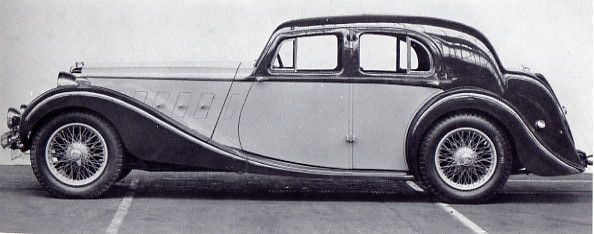
Cecil Kimber
never permitted either his MG SA or WA models to be road tested by The
Motor or by The Autocar so we can only extrapolate figures from the
power, torque and weight of the cars.
Fortunately we
do have an Autocar road test for the Wolseley 18-80 which used the
same engine as the MG SA and had similar running gear. The Wolseley
was slightly lighter than the SA but was probably slightly less
aerodynamic. Also we do have a contemporary acceleration test figure
from an SA owner who achieved 0 - 50 mph in 14 seconds based on
the dashboard speedo reading.
Michael
Sedgewick in "Cars of the Thirties" claimed that the WA could out run
the SS Jaguar 2½litre and give the SS Jaguar 3½litre a run for its
money. I suspect that the large P100 headlamps did cause the SS to be
less aerodynamic than the MGs so it is possible that the WA might have
out run the SS 2½litre although with 10 bhp less I suspect the
WA would not be ahead by much.
Looking at the
power and torque ratios it seems rather unlikely that either MG would
better the SS Jaguar 2½litre in acceleration.
The estimates
of MG top speed are taken from the BHP
Required graph and using the curve for the SS100 which has a much
lower frontal area than the SS Jaguar saloons. As a check we also have
a measured top speed of 76mph for a 1½litre MG tourer with its hood up
which probably had similar windage to the SA and WA. The tourer achieved
this with 54bhp which does follow the SS100 curve reasonably well.
| |
Wolseley 18-80 |
MG SA |
SS
Jaguar 2½litre |
MG WA |
|
Power to
weight ratio |
52.5
bhp / ton |
51.8
bhp / ton |
63.7
bhp / ton |
58.7
bhp / ton |
|
Torque to
weight ratio |
74.7
lb-ft / ton |
73.7
lb-ft / ton |
83
lb-ft / ton |
75.4
lb-ft / ton |
|
0 to 30
mph |
6.7
secs |
~ 6.7
secs |
4.7
secs |
~5.1
secs |
|
0 to 50
mph |
15.3
secs |
~ 15.3
secs |
10.6
secs |
~11.6
secs |
|
0 to 60
mph |
24.4
secs |
~ 24.4
secs |
17.0
secs |
~18.7
secs |
|
Weight |
29 cwt
36 lbs |
29 cwt
77 lbs |
32 cwt |
32 cwt
41lbs |
|
Top
Speed |
75 mph |
~85 mph |
87 mph |
~92 mph |
|
Price |
£320 |
£389 |
£395 |
£442 |
The figures for the MGs in the table are simply extrapolations.
The chassis layouts are very similar. The MG has a slightly
longer wheelbase at 10' 3" as against 10' in the Jaguar and the engine
and gearbox are perhaps an inch or two further back but I don't know
if this would be sufficient to give any handling advantage.
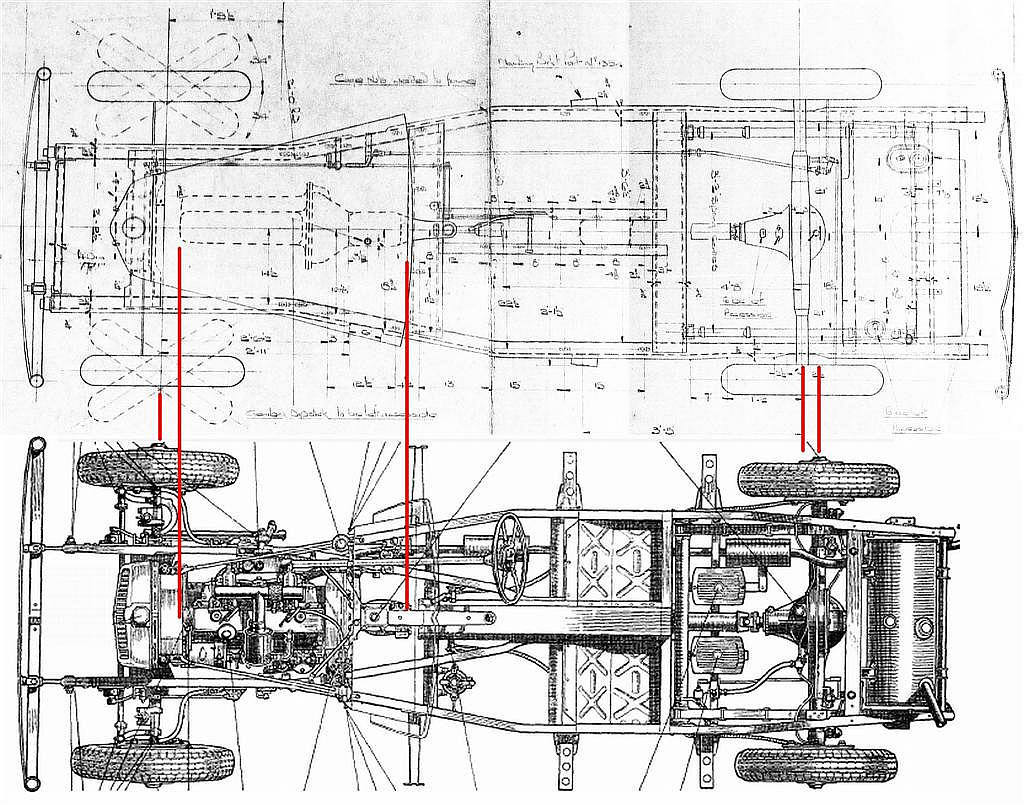
Travelling in
the MG SA
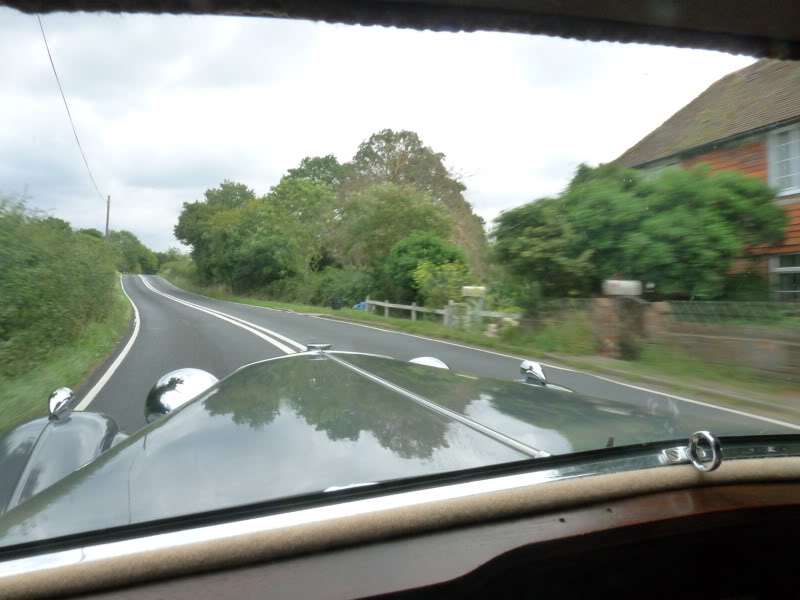
The interior of the SA is significantly
smaller than the all steel Jaguars perhaps more akin to the coach
built SS Jaguars. The seats are
very comfortable and the level of wind noise from around the
windscreen and side windows appears less than in the Jaguars. The
level of engine noise is fairly similar but the transmission sounds
much more vintage, especially as second gear is also straight cut.
Driving
Impressions
At the end of this page you can
see some experiences in
restoring MG SA GRB 988. This car is now on the road and I can start to add
driving impressions.
In June 1938 and November 1939
Laurence Pomeroy wrote in The Motor his ownership experiences
over 20,000 miles and 47,000 miles respectively in a Tickford SA.
He clearly enjoyed owning the car but with one or two
reservations. Ride comfort and braking were commented on
favourably and
these certainly mirrored my first impressions but what really
surprised me on first acquaintance was the nature of the
steering. The SS Jaguar, that is the obvious basis of comparison
for me, is heavy at parking speeds but commendably light at speed
such that it turns into corners with very little effort and has
good castor action to return you to a straight line when you let
go the wheel. The SA takes 2½
turns lock to lock for a 40' turning circle whilst the Jaguar has
slightly higher geared steering at 2¼
turns lock to lock for a 40' turning circle. I had expected the
SA
to perform in similar fashion to the Jaguar if perhaps with
slightly lighter steering. In fact the SA steering is
very heavy at all speeds and does not possess strong castor
action.
The steering in
GRB could be turned easily lock to lock with one finger
when the front wheels were jacked off the road surface and yes,
the king pins had been greased and the steering box filled with
gear oil. I did wonder
if there was something wrong with it but reading Laurence Pomperoy's articles I see that he too was less than impressed by
the steering and had fitted "the latest type of Bishop
steering gear, using roller bearings and other changes in design"
"This is by the way, a special fitting as the standard steering
is rather too heavy for my liking, although completely free from
road shock. With the high efficiency gear one can definitely feel
the road on the hand, but this is something I am willing to
accept." "it is not a car to flick through roundabouts at 50
mph,"
The lack of castor made me
wonder whether we could improve the steering by increasing the
castor angle. We have now done this and transformed the car. It
now returns to straight ahead if you let go the wheel and it
doesn't wander as it had previously. The steering also appears
lighter around the straight ahead region and the car is much more
pleasant to drive.
Although Pomeroy doesn't specifically criticise
the gearbox he does comment that he generally starts in second gear, a procedure
that no doubt contributed to the clutch renewal earlier than the 47,000 miles of
his second article. The car
certainly has very good low down torque and possibly due to a
fairly heavy flywheel is almost impossible to stall at take-off
but first gear is a bit of a stump puller and the lack of any
synchromesh in second makes for rather slow upward changes. The
heavy flywheel does make for very easy double declutching though.
In terms of performance the SA is very noticeably slower in
acceleration than the 2½ litre Jaguar but this is hardly surprising
given the figures in the performance table.
See also: Jaguar and the Gas Meter
I haven't been able to gauge the handling so far but the ride is
certainly no worse than the cart spring Jaguars.
Appearance
The SA is an elegant car but there are
some aspects of its lines that to my eyes just don't work. If you look
at the relationship between the windscreen and side windows then
nothing appears to line up and the front doors look as if they have
dropped. Compare the same aspect in the Jaguar and things appear much
more harmonious.
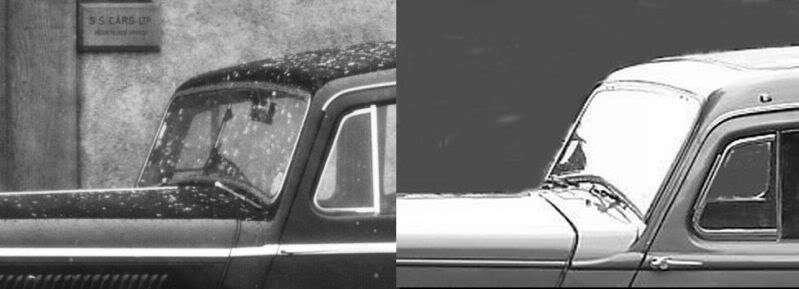
Interestingly the original
design drawing by James Wignall doesn't show the same downward slope
of the front door. Perhaps it was altered to give a less upright
appearance.
.jpg)
All in all an interesting car and more
from the early thirties than the late thirties.
But who got there first?
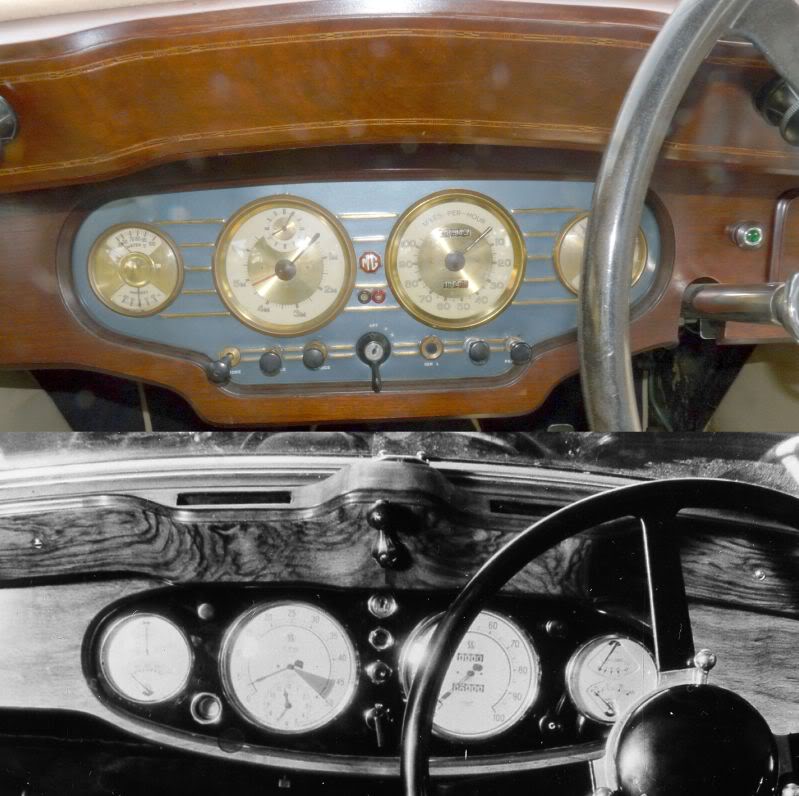
As an aside: since we are looking at the SA dashboard (in colour)
above it might be worth mentioning some of its features.
Both the speedometer and rev. counter are, in fact
chronometric
which involves a slightly more complex mechanism than the aluminium
disc and spinning magnets found in the Jaguars. They are also quite
intriguing to watch as they click up or down at fixed time intervals
when speed or revs change.
The thing that looks very like an owl's eye cigar lighter above the
steering column is in fact a 30 mph warning lamp. This detects the
speed via a switch within the speedometer body.

The little red and black terminals in the centre of the instrument
panel offer the possibility of running all sorts of electrical
accessories. The only limit on what can be powered is the current
rating of the wiring harness as these terminals run straight to the
battery without a fuse!
Customer
Loyalty
Since writing the above I've had
the opportunity to read more and gain more first hand experience of
the MG SA and have come across some interesting and some trivial
information.
I guess the first thing that amused me was the obvious displeasure of
some MG owners at the upstart company of SS Cars Ltd. and this even in
recent times:
"Many car companies of those days had taken the same economical
path to update their engines, by converting a current sv unit to ohv.
SS Jaguar did this with David Blacks (sic) 'Standard ' six cylinder sv,
using it as an ohv in their SS90 and SS100, real 'hairdressers' cars."
Unlike with the pre-war MG saloons, Cecil Kimber did permit the
motoring press to perform proper road tests on MG two seaters. The TAs
and TBs were nice fun cars to drive but I don't think many
commentators would rate their performance highly against the
substantially more powerful SS90 (even in sv form) let alone the 100.
What is clear is that the MG company went out of their way to attract
the type of owner who would perform almost all his or her own
maintenance and repairs. Perhaps it is this closer relationship
between company and owner that has instilled an almost religious
devotion in the latter? Whilst SS Cars did produce quite helpful
Instruction Books those for the SS Jaguars were hardly an invitation
to anything more than routine maintenance and as far as I know no
factory Service Manual ever existed until after the war.
In sharp contrast the "Instruction Manual for the MG Two-Litre" could
be easily mistaken for a comprehensive workshop manual. That was certainly my
first impression although reading on, it soon became clear that this
was so comprehensive because it was instructing the home mechanic to
perform tasks normally in the province of the professional. To
give you a small example here is just a couple of paragraphs from the
many that make up the electrical section:
"When the dipper switch is turned the connection to the blue wire
is broken, and instead a connection is made between the blue and white
wire which feeds the switch and the other terminal. To this are
attached two red and yellow wires which carry current direct to the
two passlights.
These two circuits are completed through the bodies of the lamps to
the bumper bar, and thence, through two flat steel strips which bridge
the silentbocs on which the bumper bar is carried, to the frame
(earth)."
.jpg)
Looking at some of the mechanical sections of the Instruction Manual
there are many similarities in the construction of the big MG to that
of the SS Jaguar. Engine similarities are perhaps not too surprising
given that both evolved from earlier side valve designs. The SS Jaguar
used valve timing of 16,56,56,16 which by virtue of its symmetry led
to very simple installation of the timing gears and chain. The MG SA
in common with other MGs of the period used 11,59,56,24 which made
installation slightly more demanding and certainly worthy of
comprehensive description, especially if you turned the starting
handle a little too far!
"It will be noticed that the timing chain has two white links, and
each of the sprockets has a tooth marked "T". Between the white links
are twelve black ones on one side of the chain and fifteen black links
on the other. The camshaft is correctly timed when each of the
"T"-marked teeth is in a white link with the shorter black portion of
the chain uppermost. The twelve black and two white links are clearly
shown in illustration No. 28, which shows one white link of the chain
engaged with the "T"-marked tooth of the camshaft sprocket, while the
"T"-marked tooth of the crankshaft sprocket has left the other white
link, twelve black links behind the first one."
This is all commendably clear when you look at illustration No. 28 but
woe betide the unwary who don't read the next paragraph!
"Owing to the fact that the total number of links in the timing
chain is a prime number, the engine must be turned fifty-eight times
before the links and marked teeth come back to this position again."
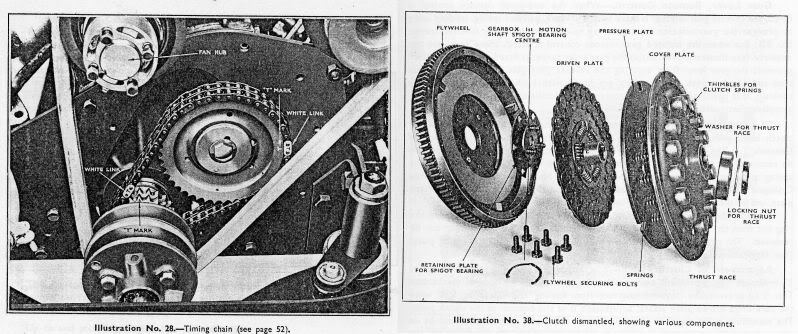
Looking at articles in "The Motor" and "The Autocar" the SS Jaguar was
first introduced on 24th September 1935 and the
MG SA only a few days
later, on the 4th October. The two cars were clearly aimed at the same
market. The MG being priced at £389 and the Jaguar at £385 but due to
their differing heritage the MG started out on the back foot and
despite various small changes and a major upgrade as the MG WA they
never really gained a march on the Jaguar.
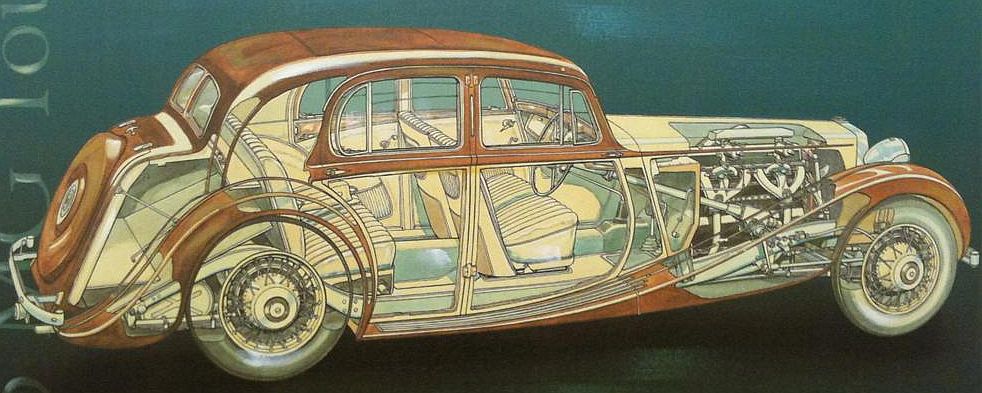
The SA started its life with an engine of 2062 cc as against the 2664
cc in the Jaguar giving the latter a nearly 30 bhp advantage in a car
that weighed the same. The Jaguar did get bigger and heavier in 1938
when coachbuilt construction gave way to all steel but despite a
couple of capacity increases the SA was always inferior in power to
weight ratio. The introduction of the WA did improve matters for MG
but this car had also gained size and weight and was still at a
disadvantage in power to weight ratio relative to the 2½ litre Jaguar.
It had also risen in price to £442 puting it very close to the even
more powerful 3½ litre Jaguar which could be had for £445.
Other facets of the MG design heritage also conspired against it. The
SS Jaguar started life with a gearbox with synchromesh on the top
three ratios driven through a dry plate clutch. In contrast the SA
inherited a totally crash gearbox with straight cut teeth on both
first and second and driven through an oil bath cork faced clutch of a
design that dated back to the early 1920s. Whilst the SA did later get
synchromesh on third and top gears it was only in 1938 that a dry
clutch and second gear synchro was available and that only on the more
expensive WA.
The big MGs are nice cars but the more I read, the more I can
understand the attitude of some MG devotees towards the SS Jaguar.
For a less SS partisan view there are lots of
interesting articles, information and photos in the
SVW website.
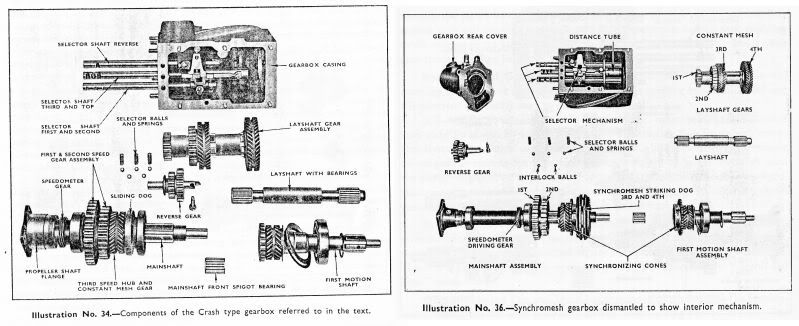
MG SA GRB 988
Click on the picture for some reports of
restoration work.
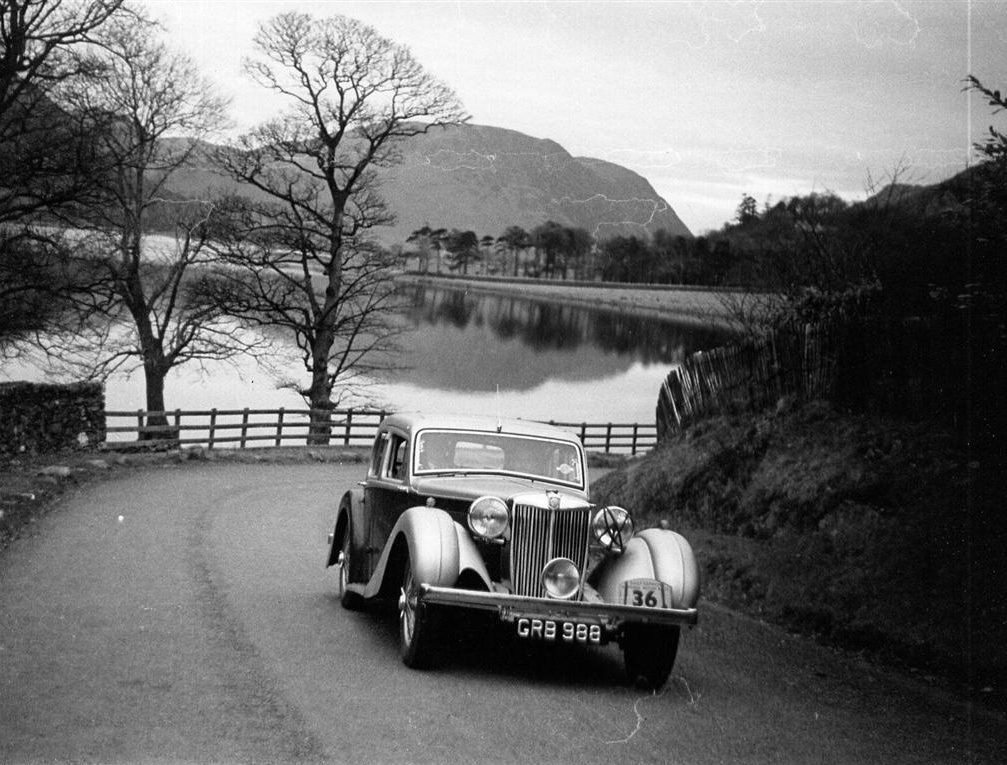
.jpg)

Linking the World of MG Cars Together
Previous Site |
Next Site |
List All Sites |
Random Site
Add Your Site |
SiteRing by Bravenet.com
| 
